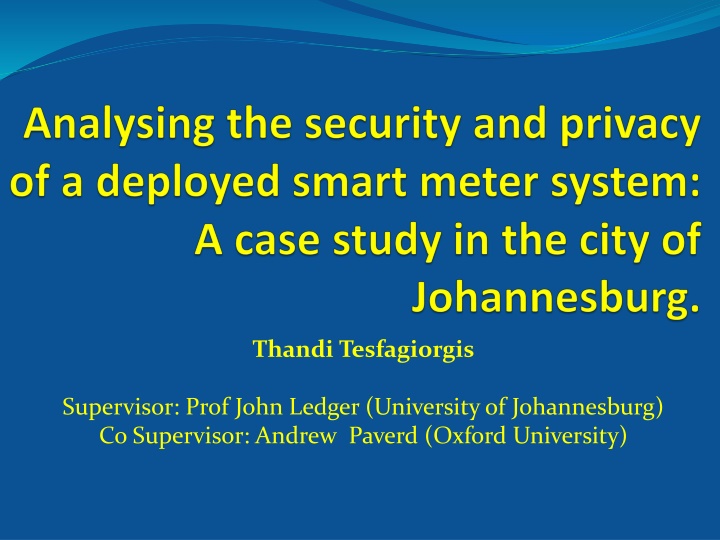
Reviewing Security and Privacy in Johannesburg Metro AMI Systems
Delve into the evaluation of Johannesburg Metro's AMI system design regarding security, privacy, local regulations, and international standards like NIST Guidelines. Explore challenges unique to South Africa and impacts of POPI on operations. Analyze necessary information for assessing the security and privacy of deployed smart metering systems.
Download Presentation

Please find below an Image/Link to download the presentation.
The content on the website is provided AS IS for your information and personal use only. It may not be sold, licensed, or shared on other websites without obtaining consent from the author. If you encounter any issues during the download, it is possible that the publisher has removed the file from their server.
You are allowed to download the files provided on this website for personal or commercial use, subject to the condition that they are used lawfully. All files are the property of their respective owners.
The content on the website is provided AS IS for your information and personal use only. It may not be sold, licensed, or shared on other websites without obtaining consent from the author.
E N D
Presentation Transcript
Thandi Tesfagiorgis Supervisor: Prof John Ledger (University of Johannesburg) Co Supervisor: Andrew Paverd (Oxford University)
AIM To review the design of the Johannesburg Metro s AMI systems in terms of security and privacy; and to evaluate this design with respect to local regulations (e.g. POPI Act; NRS049) and accepted international recommendations like NIST Guidelines for Smart Grid Cybersecurity (NIST-IR 7628).
Introduction Globally, huge amount of financial assistance has been provided by governments to support the deployment of Smart Meters system due to the system s ability to improve efficiency, grid integration of clean energy sources, recoup financial losses and ensure security of supply through DSM. City Power and Eskom have been deploying smart metering in the Johannesburg Metro.
Source: GigaOM, Software Group, IBM Institute for Business Value
Introduction Cont. Challenges of smart meter technology Public resistance in some countries due to privacy and security concern. Detailed information about a customer s energy consumption = user patterns = household s activity. Legal implication: The Protection of Personal Information Act puts the responsibility of securing personal data onto the person controlling the data (POPI Act, 2013). Standards build trust into the system and ensures that the system has interoperability and portability function which is critical for functional audits
Research Questions Is the design of the smart metering system by the Johannesburg Metro Utilities in line with international best practices and standards in terms of security and privacy? What challenges were unique to South Africa and required changes which are not fully covered by the International standard framework? How will POPI impact Operations? What information is necessary in order to analyse the security and privacy of a deployed smart metering system?
Research Methodology Semi-structured interviews used in qualitative research NISTIR 7628 Guidelines for Smart Grid Cyber Security Other accepted smart meter and smart grid standards, Local legislation such as the POPI Act (2013) and the utilities' threat models that define the final design chosen.
Key Findings Vendor Systems Landis+Gyr and Itron: 2 main vendors with AMI in the Johannesburg Metro. Their equipment and services they provide are in line with international recommendations, such as NIST- IR 7628, and follow best practices. The vendor systems are compliant with the standard. The use of Zigbee Standard was found to have a vulnerability that can be exploited under certain conditions.
Key Findings cont. Communication standards As recommended by NIST-IR 7628, the standards used in the smart grid should be open standards. Communication standards cannot be objectively superior to one another because in most implementations, there are trade-offs that depend on the user s requirements. The biggest challenge for communication standards is interoperability.(Erlinghagen et al. 2015).
Analysis and Recommendations Utility policy regarding PII 1. 2. Relationships with vendors 3. In-house data management 5. Smart grid security Manager 6. Meter reading frequency 7. Data retention 8. Event response 9. Local regulations 10. New technologies and developments
Current Development NERSA is still looking at framework that would enable homes and businesses to receive credit for feeding surplus power to the grid. The NRS049 WG published a call to the Industry in order to obtain input on the revised specification The WG recommends the used of IDIS-ZA DSM/COSEM security standard
Conclusion The widespread deployment of smart meters amplifies the consequences of security vulnerability. Remote disconnection must be carefully protected to avoid misuse, which consequences. Practices such as security by design can assist in ensuring the overall security of the system. The utilities and vendors company policies and procedures should prioritize the security and privacy aspects of this technology and these priorities should be reflected in the daily operations of these companies. could have serious
References Anderson, R., & Fuloria, S. (2010). Who controls the off switch. Proceedings of the IEEE SmartGridComm. Brown, I. (2014). Britain's smart meter programme: A case study in privacy by design. International Review of Law, Computers & Technology, 28(2), 172-184. City Power, (2015a). http://www.joburg.org.za/index.php?option%3Dcom_content%26view%3Darticle%26id%3D6393%26catid%3D88%26Itemid%3D26 6 (Accessed on 12 February 2015) City Power. (2015b) https://www.citypower.co.za/Pages/Energy-Management.aspx ( Accessed on 10 March 2015) Cohen, D., & Crabtree, B. (2006). Qualitative research guidelines project. Cuijpers, C., & Koops, B. J. (2013). Smart metering and privacy in Europe: lessons from the Dutch case. In European data protection: coming of age (pp. 269-293). Springer Netherlands. Erlinghagen, S., Lichtensteiger, B.,& Markard, J., 2015: Smart meter communication standards in Europe a comparison. Renewable and Sustainable Energy Reviews, 43, 1249-1262. Eskom (2015) http://www.eskom.co.za/OurCompany/MediaRoom/SystemStatusBulletins/Documents/SyStatus321.pdf (Accessed 19 February 2015)
References NIST-IR-7628 (2014) http://nvlpubs.nist.gov/nistpubs/ir/2014/NIST.IR.7628r1.pdf Accessed on 15 February 2015) POPI ACT, (2013). http://www.justice.gov.za/legislation/acts/2013-004.pdf (Accessed on 12 February 2015) SAICA, (2015). https://www.saica.co.za/Technical/LegalandGovernance/Legislation/ProtectionofPers onalInformationAct/tabid/3335/language/en-ZA/Default.aspx (Accessed on 12 February 2015) Torr, P. (2005). Demystifying the threat modeling process. Security & Privacy, IEEE, 3(5), 66-70. Zic, J. J., Groot, M., Liu, D., Jang, J., & Wang, C. (2012). Hardware security device facilitated trusted energy services. Mobile Networks and Applications,17(4), 564-577.
